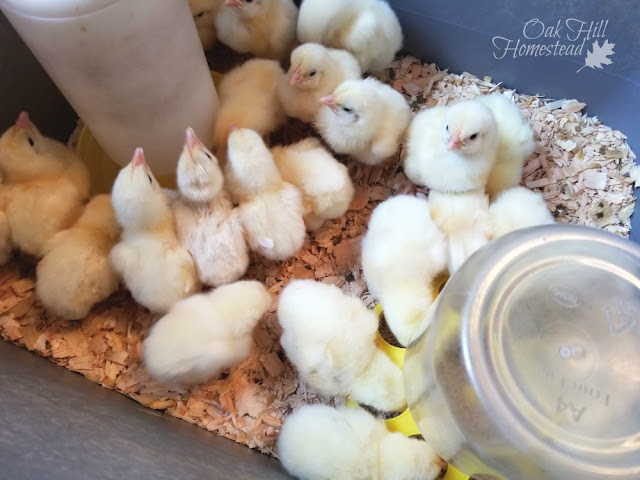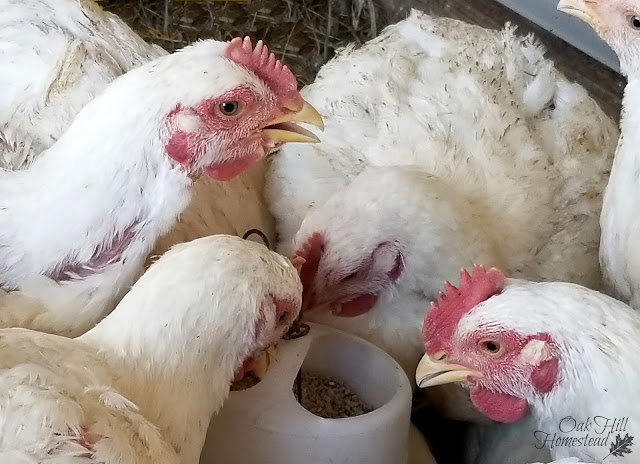Filling the Freezer with Cornish Cross Chickens
I've heard them called "Frankenbirds," but they aren't.
Cornish Cross chickens aren't genetically modified ("GMO") either. These white chickens are simply a fast-growing hybrid.
Simply put, chickens are one of the easiest livestock for man to improve by selective breeding because their life cycle is so short.
Whatever the breed, pullets (young female chickens) begin laying eggs at around six months old - some breeds are a little earlier, some are later - so the time invested before we can see the results of our experimental breeding is less than a year.
We can conceivably have two generations in just over a year's time.
Compare that to cattle, hogs and other livestock. Whether someone is breeding for show or for meat, the results of that breeding can be seen much faster in poultry than in other livestock.
Especially when the goal is a fast-growing meat bird that's harvested at 8-10 weeks old.
What are Cornish Cross chickens?
Originally called "Cornish Rock cross," these chickens are basically a cross between white Cornish and white Rock chickens.
Most people call them Cornish cross but you might find them listed on hatchery websites as Jumbo Cornish X Rocks or similarly named. Meat birds are also referred to as broilers, roasters and fryers.
Cornish Cross birds grow extremely fast, making them an ideal source of protein on the homestead.
Cornish Cross chicks grow FAST
We picked up 25 fluffy little yellow Cornish cross chicks back in October.
As always when we look at those tiny fuzzballs that weigh just a few ounces and fit easily in the palm of our hands, we think "there's no way these will be big enough to butcher by eight weeks." But they are! Trust me on this.
It didn't take long for those chicks to outgrow the big plastic bin "brooder" we always start our chicks in.
After just three days we divided them into two bins. In another week they were in the 100+ gallon water trough we use as a brooder - it leaks, but it's perfect to use in a dry situation, and the sides are tall enough to keep them inside - at least for awhile.
And when that was too small, they went into the empty duck shed until they were nine weeks old and ready to "move on out of here."
The Chief said that they doubled in size every time he looked at them, and I think he was right. I did most of the feeding chores, but even I thought they changed in size daily.
Feeding Cornish Cross chickens
Meat birds need a high-protein feed to support their fast growth.
Chick starter/grower feed is excellent at 24% protein, but I could only find medicated feed which I didn't want to feed birds that would be my food. Instead I fed ours Purina's Flock Raiser, which is 20% protein and is non-medicated.
Nutrena offers a meat bird feed with 22% protein. Sometimes I could find this brand at Tractor Supply but it was often out of stock.
Cornish cross chicks gain weight too quickly if they are allowed to eat constantly.
This leads to leg issues as their bodies become too heavy for their legs to support, as well as heart attacks as their hearts can't keep up with their fast-growing bodies.
These are just two more reason to butcher the chicks when they are 8-10 weeks old.
But there's a fine line between not feeding them enough and overfeeding them. How do you know how much to feed them?
Well, I was gone for a week when the birds were about five weeks old, and the Chief (my husband) fed them while I was gone. When I got home he said they were monsters and he was afraid for his life when he went in the pen.
They'd grown so much while I was gone that they needed more food and they were attacking the feed bowl before he even finished filling it.
He of course was giving them as much as I did when I left home, not knowing that he'd need to increase their feed while I was gone.
If you're raising Cornish cross and you think they'll attack you when you feed them, you're not feeding them enough!
Their eating habits are very different from those of laying hens. They don't forage well or nibble grass. They prefer to sit right next to the feeder and wait until it's refilled.
In fact, it's a good idea to have more than one feeder because as the chicks grow, there isn't enough room for all of the birds at the feeder. The smaller, weaker ones will be pushed away from the feed.
Of course they need more water too as they grow, to wash down and digest all that feed. I was carrying more water to the meat birds than I was to the ducks, who are notorious for playing in their water until it's all gone.
A big difference between Cornish cross and egg-laying breeds is the smell. These birds eat a lot, and in turn they, well, produce a lot of manure. Very smelly manure.
The brooder and then the coop need to be cleaned very often, and even then it's hard to keep these white birds clean.
Next time we raise them, we plan to use a chicken tractor rather than a stationary coop so that we can move them to clean ground every day. However, my compost pile is extremely happy right now with eight week's worth of chicken manure.
Accommodations for Cornish Cross meat birds
We lost just one chick, that first night that we moved them from the brooder to the coop.
Evidently wild creature reached in through the 2x4" holes in the wire door of the coop and grabbed a chick. Its head was missing and the body had been pulled out through the wire.
When building a poultry coop or run, remember that chicken wire will keep birds in, but it won't keep all predators out. We had used a heavier fencing mesh which was strong enough, but the holes were big.
After that first loss I lined the door with 1x1" wire.
Our original plan had been to get our chicks in the following spring, but we moved it up on our calendar when we had an opportunity to buy them at a good price.
The disadvantage of raising them in the fall is the weather: they need shelter from the cold. Fortunately it didn't get real cold until after they were gone.
(However, a couple of years later we raised our chicks in the spring and the hot weather in early summer was even harder on them than the fall chill. Late summer and fall is now my preferred time to raise Cornish Cross chicks.)
The nice thing about raising Cornish cross birds are that they are ready to be butchered so soon, so your time commitment is minimal, even compared to heritage chicken breeds, but especially compared to larger hoofed livestock.
You don't even have to wait till eight weeks if you don't want to. If you've ever had Cornish hen at a nice restaurant, you were eating a very young Cornish cross bird.
In comparison, we took our Rhode Island red cockerels to the processor when they were five months old.
The largest dressed Rhode Island red was 3 pounds, 14 ounces. The Cornish cross went to the processor at nine weeks old, and seven of the birds dressed out at over five pounds - the postal scale I use for soap making tops out at five pounds, so the actual weight is unknown.
Will we do it again? Absolutely yes. Twenty-four birds will put two chicken dinners on our table for almost six months since the two of us can get at least two meals from one bird.
Raising Cornish Cross might be a good source of protein for your family as well.
Read about the ten things you need to consider before you decide to raise Cornish Cross chickens.
You'll find all of my chick-raising and chicken-keeping posts here. Check it out for more information on both layers and meat birds.



















